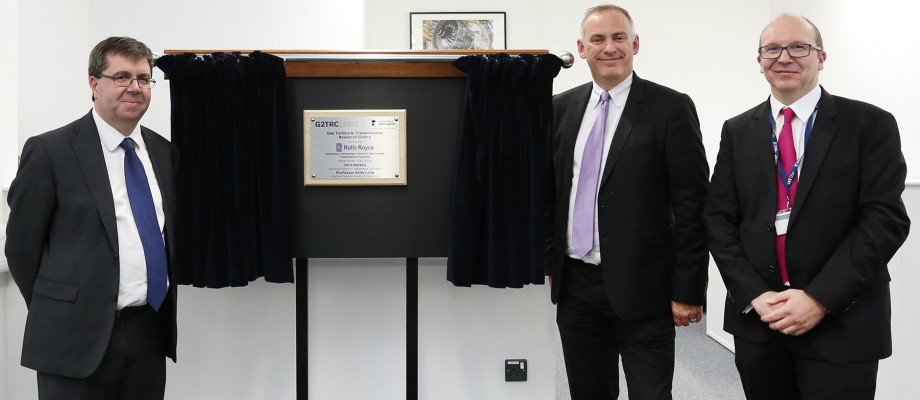
New £5.6m Research Centre to accelerate engine development
July 11th, 2016
The new Gas Turbine and Transmissions Research Centre was officially opened by Rolls Royce’s Group Director of Engineering and Technology, at Innovation Park, Jubilee Campus on Monday 4 July 2016.
The £5.6m Research Centre (G2TRC) will house the UK’s first three-shaft test rig which will provide unique national testing facilities for the design and development of safer, greener aerospace engines. Based in the Energy Technologies Building, G2TRC is also home to the Rolls-Royce University Technology Centre (UTC) in Gas Turbine Transmission Systems, which was first established in 1997.
The Centre’s Director, Professor Hervé Morvan, said: “The centre is all about enabling optimal engine heat management and cooling, reducing transmissions power losses and improving engine efficiency, developing and testing technologies to allow future engine core architectures and supporting right-first time design. These issues are central to the greening of air transport and the competitiveness of the sector.”
Over the decades, the UTC has worked closely with senior engineers at Rolls Royce, focusing on complex oil flow and transmissions projects to advance engine models. In practise, the Nottingham’s UTC has supported the design and development of engines such as the Trent 900, 1000 and XWB.
The new Centre and testing facility marks the next phase in a close collaboration, to overcome increasingly advanced technical challenges and bring to market innovative and more efficient engines.
Work on new engines
At the opening event, Chris Barkey, Group Director of Engineering and Technology at Rolls Royce, said: “Our organisations have shared a culture and foundation in engineering excellence and a 20-year relationship embedded through the transmissions topic.
“Work on the next-generation of engines, with ambitious projects such as the 25 per cent more efficient UltraFan design, also bring hard transmission challenges which the UTC’s research can help to solve.”
With access to a multiple shaft test bed, researchers at the Centre will, for example, be able to carry out unique experimental studies on a range of engine configurations, including full blown engine modules.
G2TRC and the above facility will also allow academics to validate numerical models, take them through gated reviews and transfer them to industry for use in design.
“The development, validation and demonstration of numerical tools will help companies like Rolls-Royce reduce multiple design iterations and testing, supporting its right-first-time objectives,” said Professor Hervé Morvan.
Additional research
Other research areas for the Centre include sump design; heat transfer; behaviour of bearings; thermomechanical properties of high-performance alloys; fretting and wearing at the interface of transmission systems, and mechanical fatigue of materials.
The facility will also be used for research and commercial testing for other sectors, including energy, rail, marine and automotive.
The G2TRC new facility was built following a successful funding bid to the UK’s Aerospace Technology Institute, made with significant support by Rolls-Royce. The investment will also pay for a 1,000-core high-performance computer and more staff.
The Centre now has around 50 people, including academic researchers, engineers, technicians, programme managers, PhD students and postdoctoral researchers. Undergraduates also have the opportunity to take part in research, developing their skills and working on real industry challenges.
The Centre is up and running with all researchers and PhD students and technical staff in place. The existing rigs in the test facility are being made ready to run in their new locations with major new rigs, including the three-shaft facility, which is under construction now.
Comments are closed.
Other

Need news? See you on SharePoint
After 14 years of service, Campus News is being retired as the university’s staff news platform. […]

Roads and car parks closed for refurbishing work
As part of ongoing road improvements at the university, works will be taking place to resurface […]

